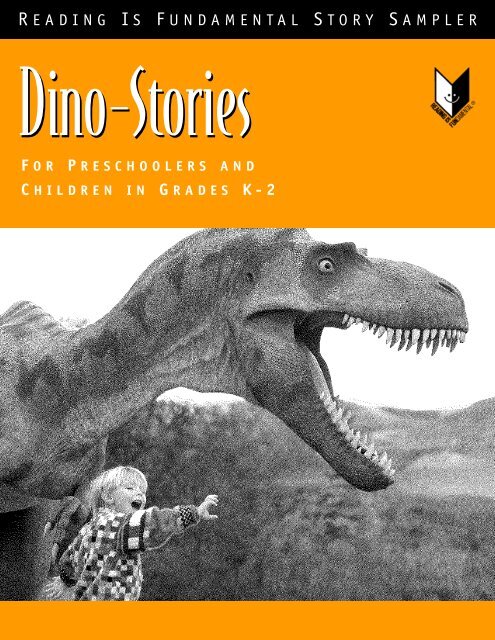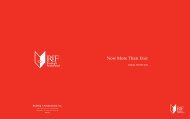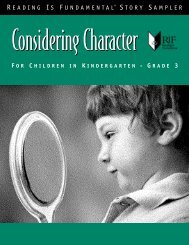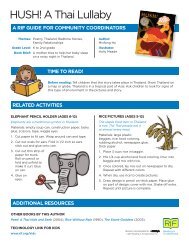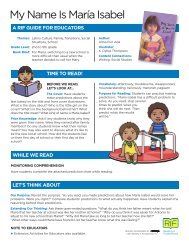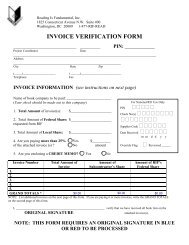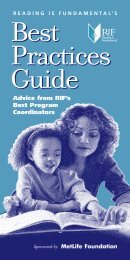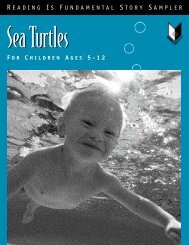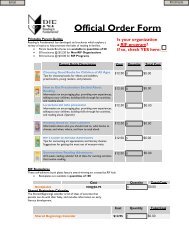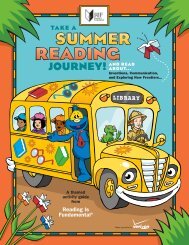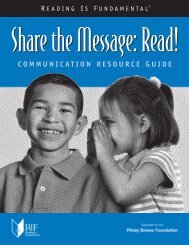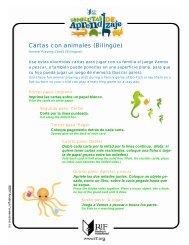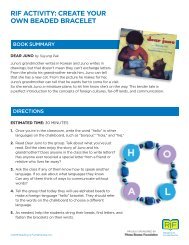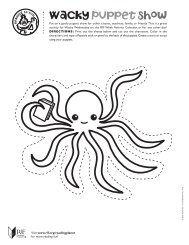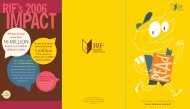Dinosaurs Story Sampler - Reading Is Fundamental
Dinosaurs Story Sampler - Reading Is Fundamental
Dinosaurs Story Sampler - Reading Is Fundamental
Create successful ePaper yourself
Turn your PDF publications into a flip-book with our unique Google optimized e-Paper software.
R EADING I S F UNDAMENTAL S T ORY S AMPLER<br />
Dino-Stories<br />
F OR P RESCHOOLERS AND<br />
C HILDREN IN G RADES K-2
Support for <strong>Reading</strong> <strong>Is</strong> <strong>Fundamental</strong>, Inc.<br />
comes from corporations, foundations,<br />
government, and other national service<br />
organizations. RIF is affiliated with the<br />
Smithsonian Institution and has been<br />
accorded tax-exempt status under Section<br />
501 (c)(3) of the Internal Revenue Code.<br />
Contributions to RIF are tax-deductible to<br />
the fullest extent of the law.<br />
<strong>Reading</strong> <strong>Is</strong> <strong>Fundamental</strong>, RIF, and the logo<br />
design showing the open book with a<br />
smiling face on it and the words <strong>Reading</strong> <strong>Is</strong><br />
<strong>Fundamental</strong> underneath it are all registered<br />
service marks of <strong>Reading</strong> <strong>Is</strong> <strong>Fundamental</strong>,<br />
Inc. All rights reserved.<br />
Created and developed by Sara Horwitz,<br />
<strong>Reading</strong> <strong>Is</strong> <strong>Fundamental</strong>, Inc.<br />
<strong>Reading</strong> <strong>Is</strong> <strong>Fundamental</strong>, Inc.<br />
1825 Connecticut Avenue, N. W.<br />
Suite 400<br />
Washington, D.C. 20009-5726<br />
Toll free: 877-743-7323<br />
Web site: www.rif.org<br />
© 2001 <strong>Reading</strong> <strong>Is</strong> <strong>Fundamental</strong>, Inc.<br />
All rights reserved.
Introduction to<br />
What <strong>Is</strong> a<br />
<strong>Story</strong> <strong>Sampler</strong>?<br />
A <strong>Story</strong> <strong>Sampler</strong> makes books come<br />
alive for children. It is a book-based<br />
thematic approach to reading designed<br />
to engage children in the book<br />
experience. Each <strong>Story</strong> <strong>Sampler</strong><br />
includes hands-on, cross-curricular<br />
activities for books that are linked by<br />
a common theme.<br />
Why Use a <strong>Story</strong> <strong>Sampler</strong>?<br />
Motivational activities are an important part of every<br />
<strong>Reading</strong> <strong>Is</strong> <strong>Fundamental</strong> program. And these motivational<br />
activities are an easy way to excite children’s interest in<br />
reading and help them associate books and reading with<br />
positive experiences and that means fun! The ideas you will<br />
find in each <strong>Story</strong> <strong>Sampler</strong> show you how to build<br />
anticipation and excitement in your RIF programs.<br />
Scores of studies show that students learn more and do<br />
better in school when their parents are involved in their<br />
education. Different types of hands-on activities enable all<br />
children to learn in different ways. Particular questions<br />
before, during, and after read aloud activities can develop<br />
high order thinking skills.<br />
Family members can encourage children to become<br />
life-long readers by reading aloud with them everyday.<br />
<strong>Reading</strong> aloud to children is one of the most effective ways<br />
support language and literacy development. Children<br />
who are read to from infancy associate reading with pleasant,<br />
warm feelings. When you invite children to participate in<br />
reading, ask open-ended questions that promote creative<br />
thinking and learning, and plan activities and experiences<br />
that allow children to expand their understanding of the<br />
story, you help them develop a love of reading.<br />
What Are the Standard Elements<br />
of a <strong>Story</strong> <strong>Sampler</strong>?<br />
Each section of the <strong>Story</strong> <strong>Sampler</strong> includes a featured book<br />
plus additional titles and resources.* The activities that<br />
accompany each section will help you develop a literacy-rich<br />
environment that contributes significantly to a child’s<br />
enjoyment of reading. The standard elements in the <strong>Story</strong><br />
<strong>Sampler</strong> include:<br />
■ Questions to ask ■ Family involvement<br />
■ Things to do ■ Community connections<br />
*The ISBN listed indicates a specific edition of the book.<br />
However, other editions may also be available through the<br />
public library or other publishers.<br />
Who Should Use a <strong>Story</strong> <strong>Sampler</strong><br />
and Where?<br />
Some <strong>Story</strong> <strong>Sampler</strong>s are age-specific, but most can be<br />
adapted to a broad range of ages. Teachers, families, and<br />
child-care providers can use them in classrooms,<br />
community centers, homes, and in Head Start sites. And<br />
most importantly, parents can extend the story beyond the<br />
classroom with home-based projects and field trips.<br />
<strong>Story</strong> <strong>Sampler</strong>s can forge relationships and shared<br />
experiences within the family and the community. Through<br />
the family, children can be introduced to many kinds of<br />
books. Books can explain and reinforce concepts; allow<br />
children to build positive self-images; stimulate discussions<br />
and thinking; increase children’s understanding of<br />
various concepts; and expand their imagination.<br />
The age range for a <strong>Story</strong> <strong>Sampler</strong> is indicated at the<br />
beginning of each set of activities.<br />
1
When and How Should I Use<br />
a <strong>Story</strong> <strong>Sampler</strong>?<br />
<strong>Story</strong> <strong>Sampler</strong>s can be used within or as a supplement to a<br />
curriculum or an after-school program. They can be part of<br />
reading challenges, reading weeks, and family involvement<br />
events. Your imagination and the interests of the children<br />
who participate in the RIF program will help determine the<br />
best way to use the <strong>Story</strong> <strong>Sampler</strong>. Enjoy and have fun!<br />
Tips for <strong>Reading</strong> Aloud<br />
Before You Read a <strong>Story</strong>…<br />
■ Make sure everyone is comfortable<br />
■ Show the cover and read the title and author of the book<br />
■ Ask the children about the cover<br />
■ Suggest things the children can look or listen for during<br />
the story<br />
During a <strong>Story</strong>…<br />
■ Change your voice to fit the mood or action<br />
■ Move your finger under the words as you read them<br />
■ Show the pictures and talk about the book as you read<br />
■ Add information or change words to help kids understand<br />
more words and explain the meaning of a new word<br />
■ Ask children to make predictions about the plot, the<br />
characters, and the setting<br />
■ Share your own thoughts about the story<br />
■ Follow the cues of the children<br />
After You Read a <strong>Story</strong>…<br />
■ Ask questions about what happened in the story<br />
■ Encourage the group to relate the story to their own<br />
experiences<br />
■ Ask children how they might feel or act if they were one<br />
of the characters<br />
■ Encourage children to share their thoughts about the<br />
story and pictures<br />
■ Extend the story with an activity or another book<br />
2<br />
▲<br />
▲ ▲ ▲ ▲<br />
Dino-Stories<br />
A STORY SAMPLER FOR<br />
PRESCHOOLERS AND<br />
CHILDREN IN GRADES K-2<br />
INTRODUCING… THE DINOSAURS!<br />
<strong>Dinosaurs</strong>, <strong>Dinosaurs</strong><br />
by Byron Barton, HarperTrophy, 1993<br />
ISBN: 006443298X<br />
DIGGING UP THE PAST<br />
Big Old Bones: A Dinosaur Tale<br />
by Carol Carrick, Clarion Books, 1992<br />
ISBN: 0395615828<br />
DINOSAURS WITH BIG APPETITES<br />
The Dinosaur Who<br />
Lived in My Backyard<br />
by B. G. Hennessy, Puffin, 1990<br />
ISBN: 0140507361<br />
MIXING THE PAST WITH THE PRESENT<br />
If the <strong>Dinosaurs</strong> Came Back<br />
by Bernard Most, Red Wagon, 1995<br />
ISBN: 0152003800<br />
GROWING UP DINOSAUR<br />
How Do <strong>Dinosaurs</strong><br />
Say Good Night?<br />
by Jane Yolen, Scholastic, 2000<br />
ISBN: 0590316818
Introducing…<br />
The <strong>Dinosaurs</strong>!<br />
<strong>Dinosaurs</strong>,<br />
<strong>Dinosaurs</strong><br />
by Byron Barton<br />
HarperTrophy, 1993<br />
ISBN: 006443298X<br />
Colorful illustrations and simple text make<br />
this a great book to introduce very young<br />
readers to the topic of dinosaurs.<br />
What To Do Before <strong>Reading</strong> the <strong>Story</strong><br />
■ Young children are often fascinated by dinosaurs and many<br />
may already be familiar with the topic. Start out by asking them<br />
if they have ever heard of dinosaurs before and what they already<br />
know about these gigantic creatures that lived so long ago.<br />
What To Talk About During the <strong>Story</strong><br />
■ The illustrations in this book are simple, yet vibrant, so make<br />
sure everyone listening can see the pictures as you read.<br />
■ Point out the features of the dinosaurs that the author describes<br />
on each page. Children will not only see the different types of<br />
dinosaurs, they will also build their vocabulary with words like<br />
“armored,” “fierce,” and “spikes.”<br />
■ Ask the children if they recognize any of the dinosaurs. Some<br />
of them may even know the names such as Stegosaurus,<br />
Triceratops, or T-Rex.<br />
What You Can Do When You Finish<br />
<strong>Reading</strong> the <strong>Story</strong><br />
■ Time can be a difficult concept for young children to grasp. Try<br />
to explain that dinosaurs were creatures that lived a long time<br />
ago when there were only plants and animals and no people<br />
living on the planet.<br />
■ Try reciting the short tune below as a fun way to kick off<br />
the topic.<br />
DINOSAURS OF LONG AGO<br />
(Choral Speaking and Role Playing)<br />
The dinosaurs lived long ago,<br />
And walked like this, and that. (Slow, heavy walk movement.)<br />
Some were large (Stretch hands upwards.)<br />
And some were small. (Crouch down.)<br />
Some liked water (Swimming motions.)<br />
And some just walked on land. (Stomp feet.)<br />
Some had wings, that flapped and flapped. (Flap arms.)<br />
Some had long necks, that stretched and stretched. (Hands on<br />
neck stretching upward.)<br />
The meanest, rudest one of all was ferocious Tyrannosaurus<br />
Rex. (Feet apart, hands clawlike, scowl and growl.)<br />
These were the dinosaurs of long ago.<br />
Goodness gracious, where did they go?<br />
Author Unknown<br />
Modified by Maria E. Torres<br />
■ Or perhaps try a different form of expression to begin<br />
talking about time.<br />
3
A Picture of Prehistoric Times<br />
Roll out some large bulletin board paper, construction paper,<br />
markers, scissors, and glue. Let the children use their<br />
imaginations to create a mural of what they think prehistoric<br />
times may have looked like millions of years ago.<br />
Family Involvement<br />
■ Have a dinosaur theme party! Visit the local library and check<br />
out several books on dinosaurs from the Additional Titles list.<br />
Make footprint invitations, decorate dinosaur eggs, and play<br />
prehistoric party games.<br />
Community Connection<br />
■ Many states have dinosaur museums and/or parks. If you<br />
happen to be visiting or live in any of the places listed on the<br />
Zoom<strong>Dinosaurs</strong>.com Web site, see what you can find out or<br />
try to get a close look at some life-size replicas.<br />
Additional Titles<br />
<strong>Dinosaurs</strong> (Eye Openers) by Angela Royston, Little Simon, 1991<br />
ISBN: 0689715188<br />
Very detailed, lifelike color photos and simple text describe<br />
basic facts for preschoolers who want to know all about the<br />
prehistoric world.<br />
4<br />
Dinosaur! by Peter Sis, Greenwillow, 2000<br />
ISBN: 0688170498<br />
A fantastic adventure begins when a little boy with a big<br />
imagination brings his toy dinosaur into the bathtub. The water<br />
in the bath becomes a prehistoric pond with dinosaurs romping<br />
all about!<br />
Big Book of <strong>Dinosaurs</strong> by Angela Wilkes, DK Publishing, 1994<br />
ISBN: 1564587185<br />
The oversized two-page spreads in this book allow young children to<br />
experience the awesome features of the great dinosaurs of long ago.<br />
The Day of the Dinosaur by Stan Berenstain, Random House, 1987<br />
ISBN: 0394891309<br />
Beginning readers will enjoy this informative rhyming text that<br />
also includes pronunciation labels for some of the more common<br />
dinosaur names.<br />
Curious George and the Dinosaur by Margaret Rey, Houghton<br />
Mifflin Company, 1989<br />
ISBN: 0395519365<br />
Curious George finds it difficult to keep out of trouble. His visit<br />
to the museum to see the dinosaurs winds up with his curiosity<br />
getting the better of him as usual.<br />
Set of Books by Aliki:<br />
■ Fossils Tell of Long Ago (HarperTrophy, 1990),<br />
■ Dinosaur Bones (HarperTrophy, 1990),<br />
■ My Visit to the <strong>Dinosaurs</strong> (HarperTrophy, 1985),<br />
■ Digging Up <strong>Dinosaurs</strong> (HarperTrophy, 1988),<br />
■ <strong>Dinosaurs</strong> Are Different (HarperTrophy, 1996)<br />
Aliki’s fun illustrations, lively text, and cartoon-like bubbles<br />
will capture children’s attention while they learn all about<br />
dinosaurs.
Digging Up<br />
the Past<br />
Big Old Bones:<br />
A Dinosaur Tale<br />
by Carol Carrick<br />
Clarion Books, 1992<br />
ISBN: 0395615828<br />
Professor Potts finds some very large bones<br />
and brings them back to his laboratory to<br />
reassemble. However, the skeleton that he<br />
produces never seems quite right. He tries<br />
different combinations, but it is not until<br />
his wife adds a little something<br />
extra that he is ready to<br />
unveil his latest<br />
discovery.<br />
What To Do Before <strong>Reading</strong> the <strong>Story</strong><br />
■ Read the title of the book to the children and ask them why<br />
“Big Old Bones” might be a “Dinosaur Tale.”<br />
■ Find out if any of the children know how we have learned so<br />
much about these ancient creatures.<br />
■ Once the children have had a chance to share what they know<br />
about dinosaurs, begin reading the story. Be sure to share all<br />
the wonderful illustrations.<br />
What To Talk About During the <strong>Story</strong><br />
■ In the beginning of the story, Professor Potts’ dog discovers a<br />
large bone on their trip across the country. This leads to an<br />
even larger discovery. Ask the children what they think the<br />
professor has found. Ask them what they would do if they<br />
found a very large bone in the ground.<br />
■ In the middle of the story, the professor thinks that he is wrong<br />
again because he cannot believe that an animal that size could<br />
ever walk the Earth. Ask the children if they think he is right or<br />
wrong about the animal’s size.<br />
■ On the very last page of the book, the author tells the reader<br />
how dinosaur bones were discovered in the 1800’s and how<br />
many people, like Professor Potts, made mistakes when trying<br />
to put all the pieces together. Sometimes, heads were put on the<br />
wrong end or the tip of a dinosaur’s thumb was mistaken for a<br />
nose horn. Share these mistakes with the children and then try<br />
a game of “Pin the Horn on the Triceratops.” (Just like Pin the<br />
Tail on the Donkey, except with a large picture of a Triceratops<br />
and a horn instead of a tail.)<br />
5
What You Can Do When You Finish<br />
<strong>Reading</strong> the <strong>Story</strong><br />
■ Ask the children where and when the story takes place.<br />
■ Find out if they think the story is true. Then explain that parts<br />
of it are true, but the overall story is fictional.<br />
■ Ask the children to think about how we have learned about<br />
dinosaurs if we were not around when they were alive. Show<br />
the children how their footprint can make a mark in the mud,<br />
concrete, or snow (depending on the season or available<br />
resources). When we see a footprint or a handprint, we know<br />
that someone has been there. Explain that we have learned<br />
about dinosaurs in much the same way.<br />
Digging for Dinosaur Bones<br />
Use either a dry sandbox or a plastic sheet or garbage bag with<br />
sand on top for your archeological dig. Before the children arrive,<br />
bury some dog biscuits of various sizes and/or some plastic skeleton<br />
bones if you have them available. If the children in your group are<br />
very young, plant a few of the bones so that they are sticking up<br />
out of the sand to give them a head start. When you are ready to<br />
have the children begin digging, give them some plastic shovels<br />
and either a pail or a plastic baggie. Let them dig for a few minutes<br />
and encourage them to find as many bones as they can.<br />
If you have the time, number the bones in sequential order with a<br />
marker and then bury them randomly. Grab some butcher paper<br />
and create a dot-to-dot dinosaur. When the children find the<br />
bones, have them match the number on the bone to the number<br />
on the drawing. When all the bones have been placed or glued<br />
onto the drawing, a large dinosaur with actual bones will be the<br />
result. This is a fun way for young kids to see how archeologists<br />
try to piece together these magnificent creatures from long ago.<br />
*If you want to try a similar activity that involves less preparation,<br />
take out a simple puzzle and lay out all the pieces. Ask the children<br />
what will happen when all the pieces are put together. Explain that<br />
dinosaur bones are like puzzle pieces. When they are put together,<br />
we can see what the dinosaurs looked like and how large they<br />
were when they walked the Earth.<br />
Family Involvement<br />
■ Understanding how dinosaur bones were fossilized over<br />
millions of years can be a hard concept to grasp; however,<br />
learning how you can preserve your own fossils is not only<br />
fun, but may also help young children gain a better sense of<br />
the fossilizing process. You will need to gather a small paper<br />
cup, craft plaster, a small seashell, a hammer and a chisel, or a<br />
small screwdriver. Roll up sleeves or put on an old T-shirt<br />
before you get started. Follow these directions, and let your<br />
child take the lead when safe and appropriate.<br />
6<br />
DIRECTIONS:<br />
First, mix up the plaster and fill the paper cup halfway. Then<br />
place the seashell in the plaster, but don’t let it sink to the<br />
bottom. Cover the shell with the rest of the plaster and let the<br />
mixture sit until completely dry. Once the plaster is dry, slowly<br />
peel away the paper cup from the plaster mold. Lay the mold<br />
on its side and place the chisel in the middle. Gently tap the<br />
chisel with the hammer until the top half of the mold breaks<br />
away.What should be left is your seashell fossil!<br />
Community Connection<br />
■ Fossils help us learn about the past. Find out if any<br />
archaeological digs have taken place in or around your<br />
community. Although dinosaur bones may not have been<br />
found anywhere near you, other types of unearthed objects<br />
may have been discovered that have provided clues to the past.<br />
Additional Titles<br />
Bones, Bones, Dinosaur Bones by Byron Barton, Ty Crowell<br />
Co., 1990<br />
ISBN: 0690048254<br />
Byron Barton uses a simple, but colorful approach to the topic of<br />
paleontology that young children will enjoy reading.<br />
Digging Up <strong>Dinosaurs</strong> or Dinosaur Bones by Aliki,<br />
HarperTrophy, 1988 and 1990<br />
ISBN: 0064450783 and ISBN: 0064450775<br />
Aliki’s fun illustrations, lively text, and cartoon-like bubbles will<br />
capture children’s attention while they learn all about dinosaurs.<br />
Be a Dinosaur Detective by Dougal Dixon, Unknown, 1988<br />
ISBN: 0822595389<br />
This book not only talks about how dinosaurs lived based on<br />
the knowledge scientists have gathered from fossils, but also<br />
includes instructions for making dinosaur models and other<br />
related activities.<br />
How I Captured a Dinosaur by Henry Schwartz, Orchard<br />
Books, 1993<br />
ISBN: 053107028X<br />
Liz Bradford, an eight-year-old girl, brings back an Albertosaurus<br />
from her vacation, a dinosaur formerly believed extinct for 60<br />
million years.<br />
Cam Jansen and the Mystery of the Dinosaur Bones (Cam<br />
Jansen Adventures Series #3) by David A. Adler, Puffin, 1997<br />
ISBN: 0140387153<br />
Cam, in her usual detective mode, notices some bones missing<br />
from the museum. Beginning readers will love following the clues<br />
that help Cam solve the mystery.
<strong>Dinosaurs</strong> with<br />
Big Appetites<br />
The Dinosaur<br />
Who Lived<br />
in My Backyard<br />
by B. G. Hennessy<br />
Puffin, 1990<br />
ISBN: 0140507361<br />
A little boy who stares dreamily out his<br />
backyard window tells the reader what it<br />
was probably like millions of years ago<br />
when dinosaurs roamed the Earth.<br />
What To Do Before <strong>Reading</strong> the <strong>Story</strong><br />
■ The little boy telling the story tries to imagine what it was like<br />
millions of years ago when dinosaurs roamed the Earth and<br />
there were no people. Although he is aware that his backyard<br />
did not really exist during the time the dinosaurs lived, the<br />
illustrations reveal what it would have looked like if they did.<br />
■ Explain to the children that the little boy is pretending. He<br />
knows that dinosaurs do not live in people’s backyards, but he<br />
wants to picture what it would have looked like if they did.<br />
What To Talk About During the <strong>Story</strong><br />
■ As you read, point out some of the interesting size<br />
comparisons such as the swing-set, the basketball, the car,<br />
and the sandbox.<br />
■ Ask the children questions as you read. Why did the dinosaurs<br />
eat lots of vegetables? Why would the ground shake as they<br />
walked? Why did some dinosaurs fight?<br />
What You Can Do When You Finish<br />
<strong>Reading</strong> the <strong>Story</strong><br />
■ Ask the children where else the story could take place. Do they<br />
think a dinosaur could really live in a backyard?<br />
■ Point out that at the very end of the story, the little boy says that<br />
he is saving all his lima beans for the dinosaurs just in case they<br />
come back. A lima bean is a vegetable. Ask the children what<br />
kinds of vegetables they like to eat. Ask them to think about what<br />
vegetables or greens the dinosaurs ate many years ago. Then<br />
explain that some dinosaurs were vegetable eaters (herbivores),<br />
some dinosaurs were meat eaters (carnivores), and some<br />
dinosaurs ate both meat and vegetables (omnivores). Explain to<br />
the children that even though we were not alive during the time<br />
of the dinosaurs to know what they ate, we can tell what kind<br />
of eaters they were by looking at the shape of their teeth.<br />
■ Show the children the page from the story where a dinosaur is<br />
revealing his sharp teeth. Gather several handheld mirrors for<br />
the children to share. Show them how to examine their teeth to<br />
see the varying shapes of teeth in their mouth. Some of the<br />
children may not have all their teeth, so try to demonstrate on<br />
your own mouth. Show the kids how the front teeth are long,<br />
wide, and flat. Then show them that the next ones are round<br />
and have a point. Explain that there is only one of these longer<br />
ones on each side of the mouth. Show them your molars next.<br />
Point out how they are round and short but rough on the top.<br />
Also, point out how everyone has the same set on top as they<br />
do on the bottom.<br />
■ After the children have had a chance to examine their own<br />
teeth, ask them what they notice and why might certain teeth<br />
be flat, round, or sharp. Then pass out some bite size pieces of<br />
food such as cheese, carrots, celery, and if possible chicken or<br />
beef. As the kids chew their snack, try to get them to notice<br />
which teeth they are using. Explain that each type of tooth has<br />
a special job. Ask them which teeth they think are for biting?<br />
Grinding? Tearing? Talk about what would happen<br />
if we didn’t use certain teeth.<br />
7
■ When you have finished reading the story, take the children<br />
outside. Try to find some of the things that the little boy in the<br />
story compared to the dinosaur’s size such as a sandbox, a car,<br />
a house, or a playground. Making comparisons to objects that<br />
the children are familiar with will give them a sense of how big<br />
some of the dinosaurs were.<br />
■ Try singing the following song to the tune of “I’m a Little<br />
Teapot.” Repeat the chorus after each verse.<br />
8<br />
Sing I’m a Brontosaurus with four feet.<br />
I eat plants, but don’t eat meat.<br />
Known as Thunder Lizard, that is true.<br />
’Cause when I walked, the Earth just shook.<br />
Tyrannosaurus Rex’s my name.<br />
King of the dinosaurs, that I am.<br />
I make many run and hide.<br />
’Cause I’m mean and like to fight.<br />
Chorus <strong>Dinosaurs</strong>, dinosaurs, that we know.<br />
Some were large, some were small.<br />
Fossils tell us this is so,<br />
’Cause I’ve not seen one after all.<br />
I’m Triceratops, with three horns.<br />
A big, big head, and frilly bones.<br />
I’m a fierce fighter, on four feet.<br />
But I eat plants, they are neat.<br />
Family Involvement<br />
■ Visit the zoo or the aquarium with your children and check out<br />
all the different types of animals. In the time of the dinosaurs,<br />
there were not only many different kinds of dinosaurs, but<br />
there were also various types of animals. See if you can find any<br />
animals that are alive today that existed in some form millions<br />
of years ago. (HINT: Bears, crocodiles, turtles, and whales are<br />
all descendents of prehistoric animals.)<br />
■ Have a little fun with your children while you talk about what<br />
kind of environments dinosaurs lived in and what kinds of food<br />
they ate when they roamed the Earth. Make an edible dinosaur<br />
habitat! Follow the recipe below, play a little in your prehistoric<br />
land, and then munch away!<br />
Ground: Graham crackers or soft flour tortillas<br />
Volcanoes: Sugar cones<br />
Lava: Strawberry syrup or icing gel<br />
Boulders: Peanuts<br />
Grass, Rivers, and Ponds: Colored icing<br />
Trees: Spearmint leaves (candy)<br />
<strong>Dinosaurs</strong>: Fruit snack dinosaurs<br />
Community Connection<br />
■ Do you think a dinosaur lived in your backyard? Find<br />
out where in the world fossils have been found. Visit the<br />
Zoom<strong>Dinosaurs</strong>.com Web site and check to see if any dinosaur<br />
bones were found in your neighborhood.<br />
Additional Titles<br />
Dinosaur Bob and His Adventures with the Family Lazardo<br />
by William Joyce, HarperCollins, 1995<br />
ISBN: 0060210745<br />
The Lazardo family finds Bob on one of their annual family<br />
vacations. Not being able to bear the thought of leaving Bob<br />
behind, they bring him home to Pimlico Hills, where he becomes<br />
more than just the Lazardo’s favorite dinosaur.<br />
Dinosaur Garden by Liza Donnelly, Unknown, 1991<br />
ISBN: 0590431722<br />
The little boy in this series loves dinosaurs, so he plants a garden<br />
to attract plant-eating friends.<br />
How Big Were the <strong>Dinosaurs</strong>? by Bernard Most, Voyager Picture<br />
Book, 1995<br />
ISBN: 0152008527<br />
Everyone knows that the dinosaurs who lived millions of years<br />
ago were gigantic, but just how big were they? Could they fit<br />
inside a school bus? Did their body lengthwise take up an entire<br />
football stadium? Read and find out!<br />
Dinosaur Days by Linda Manning, Troll, 1993<br />
ISBN: 0816733163<br />
The different days of the week are filled with an assortment of<br />
dinosaurs that create a tremendous amount of chaos as well as<br />
tons of fun!<br />
What Happened to the <strong>Dinosaurs</strong>? by Franklyn Branley and<br />
illustrated by Simont Marc, HarperCollins, 1991<br />
ISBN: 0064451054<br />
<strong>Dinosaurs</strong> lived over 65 million years ago, but no one really knows<br />
why they became extinct. The author in this story describes some<br />
theories scientists have come up with by digging for the answers.<br />
Tyrannosaurus Tex by Betty G. Birney, Houghton Mifflin Co.<br />
(Juv), 1996<br />
ISBN: 0395816548<br />
A creature in a ten-thousand gallon hat helps Pa and the cowboys<br />
from the Bar Double U ranch save their cattle from a band of<br />
lowdown rustlers. A tale for Pecos Bill!<br />
Dinorella: A Prehistoric Fairy Tale by Pamela Duncan Edwards,<br />
Hyperion Press, 1999<br />
ISBN: 0786811730<br />
The classic Cinderella tale told dinosaur style.<br />
Prehistoric Pinkerton (Pied Piper Paperbacks) by Steven<br />
Kellogg, Dial Books for Young Readers, 1991<br />
ISBN: 0140546898<br />
In his usual silliness, Steven Kellogg writes about a mischievous,<br />
yet lovable dog that ends up in a dinosaur costume and creates<br />
chaos at a museum.
Mixing the Past<br />
with the Present<br />
If the <strong>Dinosaurs</strong><br />
Came Back<br />
by Bernard Most<br />
Red Wagon, 1995<br />
ISBN: 0152003800<br />
A little boy thinks about dinosaurs all the<br />
time and imagines what it would be like if<br />
they came back.<br />
What To Do Before <strong>Reading</strong> the <strong>Story</strong><br />
■ Show the children the cover of the book and read them the<br />
title. Ask them why the dinosaurs are walking in between all the<br />
buildings. Try to have them make the connection between the<br />
title and the illustration on the cover.<br />
■ Ask the children what they think it would be like if the<br />
dinosaurs came back. What would happen to the place that<br />
they live? Would the dinosaurs help out around town or would<br />
they find it hard to manage because they are so big?<br />
What To Talk About During the <strong>Story</strong><br />
■ The little boy in the story says that he thinks about the dinosaurs<br />
all the time. Ask the children if there is anything that they happen<br />
to think about a lot. Do they think about the dinosaurs or<br />
perhaps the pandas at the zoo? This is a great way to find out<br />
what might be on their minds or might be of interest to them.<br />
■ The little boy talks about all the different jobs that the<br />
dinosaurs could do if they were alive today. Ask the children<br />
how they think the dinosaurs would be most helpful. Why?<br />
■ The little boy thinks the dinosaurs would be serious helpers to<br />
the community because of their size. But what if they didn’t<br />
understand their job? Ask the children how they think they<br />
would go about training a dinosaur to do what they want.<br />
9
What You Can Do When You Finish<br />
<strong>Reading</strong> the <strong>Story</strong><br />
■ Throughout the story the main character provides his thoughts<br />
on what might happen if the dinosaurs came back. When you<br />
have finished the book, ask the children what they think. Could<br />
human beings and dinosaurs really live together? What would<br />
they eat? Would they be kept in a zoo?<br />
■ Have the children draw a picture of what they think it would<br />
look like if the dinosaurs came to their town.<br />
■ The book ends with the idea of<br />
dinosaurs as pets. Ask the<br />
children if they would like a<br />
dinosaur as a pet. If so, why?<br />
What would be fun about<br />
having a dinosaur as a pet?<br />
What might be hard? Ask the<br />
children if any of them have<br />
pets at home. If so, ask them<br />
to briefly talk about what it<br />
is like to have a pet. What<br />
is fun about having a pet?<br />
What’s hard about it?<br />
Can I Have a Stegosaurus, Mom?<br />
Read the story Can I Have a Stegosaurus, Mom? Can I? Please!?<br />
or Can I Have a Tyrannosaurus Rex, Dad? Can I? Please!? both<br />
by Lois G. Grambling. Both of these stories are cute and describe<br />
all the advantages of having a dinosaur as a pet from a young<br />
child’s perspective.<br />
Measure a Dinosaur!<br />
Gather about 50 feet of string or rope. If weather permits, take<br />
your group of children outside, otherwise try this activity in a<br />
long hallway or gymnasium. Take a yardstick or a tape measure<br />
and measure the height of a few of the children in your group.<br />
Then ask all of the children to guess the size of a dinosaur. Give a<br />
few of the children a piece of the string or rope and have them<br />
walk it out to represent the size of the dinosaur. Explain to the<br />
children that you have cut a piece of string that is 50 feet long and<br />
that dinosaurs used to be as long as the rope. Ask a few of them<br />
to lie down head to foot to see how small they are in comparison<br />
to the big dinosaurs of long ago.<br />
Family Involvement<br />
■ Read the book How Big Were the <strong>Dinosaurs</strong>? by Bernard Most.<br />
Read it together. Then go on a little scavenger hunt for some of<br />
the items mentioned in the story. For example, a toothbrush, the<br />
front door of your home, a school crossing sign, the aisle in a<br />
large supermarket, a school bus, etc. All the items and places<br />
mentioned in the book will be familiar to a young child and will<br />
make the concept of the dinosaur’s size relevant to his/her life.<br />
10<br />
Community Connection<br />
■ Take a walk around your community and check out what has<br />
changed in the past few years. Have the children draw street<br />
maps of the neighborhood. Compare their new maps to old<br />
street maps. Have new roads been paved? New buildings<br />
constructed? Has land been cleared to make way for a park or<br />
a shopping mall? Find out how the community you live in has<br />
evolved over time.<br />
Additional Titles<br />
Danny and the Dinosaur by Syd Hoff, HarperTrophy, 1993<br />
ISBN: 0064440028<br />
No child will be scared of this dinosaur. Danny’s friend is quite<br />
tame and very friendly.<br />
Happy Birthday Danny and the Dinosaur! by Syd Hoff,<br />
HarperTrophy, 1997<br />
ISBN: 0064442373<br />
An old classic brought into color, Danny and the dinosaur go on<br />
an adventure!<br />
Danny and the Dinosaur Go to Camp by Syd Hoff,<br />
HarperTrophy, 1998<br />
ISBN: 0064442446<br />
Danny and his dinosaur friend go to sleepaway camp in this story.<br />
Patrick’s <strong>Dinosaurs</strong> by Carol Carrick, Houghton Mifflin Co.<br />
(Juv), 1985<br />
ISBN: 0899194028<br />
One day while at the zoo, Patrick’s older brother tells him all<br />
about dinosaurs. Patrick’s imagination gets the best of him, and<br />
he scares himself silly picturing what life must have been like<br />
when the dinosaurs roamed the Earth.<br />
What Happened to Patrick’s <strong>Dinosaurs</strong>? by Carol Carrick,<br />
Clarion 1988<br />
ISBN: 0899197973<br />
Patrick and his older brother are back, questioning and of course<br />
imagining why the dinosaurs disappeared.<br />
The Magic School Bus in the Time of the <strong>Dinosaurs</strong>: (Magic<br />
School Bus Series) by Joanna Cole, Scholastic, Inc., 1995<br />
ISBN: 0590446894<br />
Mrs. Frizzle is up to her usual out-of-this-world class fieldtrips<br />
once again. This time, the gang travels back in time to the late<br />
Triassic period.
Growing Up<br />
Dinosaur<br />
How Do <strong>Dinosaurs</strong><br />
Say Good Night?<br />
by Jane Yolen and Mark Teague<br />
Scholastic, 2000<br />
ISBN: 0590316818<br />
A cute story in which dinosaurs mirror<br />
the bedtime antics of children saying<br />
good night.<br />
What To Do Before <strong>Reading</strong> the <strong>Story</strong><br />
■ Before you introduce the story to the children, ask them about<br />
their bedtime routines. What do they do before bedtime? Do<br />
they brush their teeth, read a story, or beg to stay up later?<br />
■ After all the kids have had a chance to share their bedtime<br />
rituals, read the title of the book and show them the cover.<br />
Check for their reactions and play up the idea of dinosaurs<br />
being tucked into bed.<br />
What To Talk About During the <strong>Story</strong><br />
■ The book begins with the question “How does a dinosaur say<br />
good night....” Ask the children to make some predictions.<br />
■ As you read, encourage the children to act out what they hear.<br />
■ Read slowly and give the children plenty of time to look at the<br />
funny illustrations.<br />
What You Can Do When You Finish<br />
<strong>Reading</strong> the <strong>Story</strong><br />
■ The dinosaurs in this story end up setting a good example. Ask<br />
the children if that is how they think a dinosaur would really<br />
say good night.<br />
■ Ask them if they know what the name “dinosaur” means.<br />
Explain that the word “dinosaur” actually means “terrible<br />
lizard.” The children may find this somewhat silly.<br />
Encourage them to think about baby or<br />
young dinosaurs as big lizards. Ask<br />
them how they think baby<br />
dinosaurs are born. Then explain<br />
that like lizards, dinosaurs<br />
hatched from eggs.<br />
11
■ Talk about other animals we know about today that lay eggs.<br />
Ask the children to think about what happened to the baby<br />
dinosaurs once they hatched. Did they need food, water, a<br />
place to sleep?<br />
Baby <strong>Dinosaurs</strong><br />
Collect brown paper bags from your local grocery store or some<br />
brown butcher paper. Gather a hole punch, scissors, newspaper<br />
or facial tissue, and stencils of dinosaurs. Trace two of the same<br />
dinosaur stencils on the paper bag or butcher paper and cut them<br />
out. Staple the two shapes together to make a stuffed animal,<br />
leaving an opening large enough to insert the stuffing. Decorate<br />
the animals. Stuff pieces of crumpled newspaper or tissue into<br />
the shapes. Once the dinosaur is stuffed, staple the opening.<br />
Dinosaur Features<br />
Use materials from the arts and crafts area to recreate some of the<br />
dinosaurs, and their various attributes, seen in Byron Barton’s<br />
book. Gather some construction paper, scissors, Popsicle sticks,<br />
and glue. Cut out some of the dinosaur features mentioned in the<br />
book like horns, spikes, clubs, tails, armored plates, and sharp<br />
teeth. Create several outlines of different size dinosaurs and make<br />
enough copies for all the children. Give each child a dinosaur<br />
outline (or stencil), markers, glue, and various cutouts. Have<br />
them color their dinosaur and then paste on the features they<br />
think it should have, so that it becomes their very own dinosaur!<br />
Family Involvement<br />
■ How do you and your children say good night? Create a family<br />
ritual (if you do not already have one) that includes sharing a<br />
story, bedtime hugs, and wishes for sweet dreams!<br />
■ Read the story Chickens Aren’t the Only Ones by Ruth Heller,<br />
Paper Star, 1999, a terrific story about animals that lay eggs.<br />
Then try making some dinosaur eggs!<br />
Gather some four-inch balloons, some very small plastic<br />
dinosaurs, tape, strong cord or dental floss, a cup of all-purpose<br />
flour, a cup of water, newspaper cut into five-inch strips, a pin,<br />
and some tempura paints.<br />
Step 1:<br />
Put the tiny plastic dinosaurs into the balloon through the<br />
neck. Then blow up and knot the balloon. Tape an end of the<br />
cord to the center of the balloon and wrap it once around<br />
the middle.<br />
Step 2:<br />
Mix together the flour and water to make a smooth paste.<br />
Individually dip newspaper strips into the paste, skim off the<br />
excess paste with your fingers, and lay the strips over the cord<br />
to cover the balloon.<br />
12<br />
Step 3:<br />
Wrap the cord around the balloon a second time and cover it<br />
with another layer of newspaper strips. Smooth the top layer<br />
with your fingers. Trim the untaped cord end so that it is two<br />
inches long, but do not paste it down.<br />
Step 4:<br />
Set the balloon on a wire rack until it is completely dry<br />
(about 24 hours).<br />
Step 5:<br />
Then push a pin through one end of the shell to pop the<br />
balloon. Finally, paint the egg and let it dry. (Note: Be sure to<br />
remove the deflated balloon as soon as your child cracks<br />
open the egg.)<br />
This idea comes from Family.com<br />
http://family2.go.com/crafts/famf/macheegg/macheegg.html<br />
Community Connection<br />
If you live near a museum that has a dinosaur exhibit, they may<br />
have replicas of dinosaur eggs that children can touch and feel.<br />
Or try to find a local chicken farm that raises baby chicks.<br />
Additional Titles<br />
Dinosaur Babies (Let’s Read and Find Out: Science Stage 2)<br />
by Kathleen Weidner Zoehfeld, HarperTrophy, 1999<br />
ISBN: 0064451623<br />
The author uses gentle illustrations and clear text to describe how<br />
dinosaur newborns hatched from eggs and survived with the help<br />
of maternal protection from meat-eating predators.<br />
The Last Dinosaur Egg by Andrew Hegeman, Winslow Press, 1998<br />
ISBN: 189081704X<br />
When two little children catch a baby dinosaur egg in their<br />
butterflynet instead of a butterfly, many adventures ensue.<br />
Young children who long to have a pet will love reading about<br />
what it’s like to care for a baby dinosaur.<br />
A Dinosaur Named After Me by Bernard Most, Harcourt Brace,<br />
1995<br />
ISBN: 0152234934<br />
One of several Bernard Most Dinosaur books, this particular one<br />
encourages young children to play with the idea of naming<br />
dinosaurs after themselves.
RIF’S MISSION<br />
<strong>Reading</strong> <strong>Is</strong> <strong>Fundamental</strong>, Inc. (RIF) develops and delivers<br />
children’s and family literacy programs that help prepare<br />
young children for reading and motivate older children<br />
to read. Through a national network of teachers, parents,<br />
and community volunteers, RIF programs provide books<br />
and other essential literacy resources to children at no<br />
cost to them or their families. RIF’s highest priority is the<br />
nation’s neediest children, from infancy to age 11.<br />
ABOUT RIF<br />
Founded in 1966 in Washington, D.C., RIF is the<br />
nation’s oldest and largest nonprofit children’s literacy<br />
organization, with programs operating nationwide in<br />
18,000 schools, child-care centers, libraries, hospitals,<br />
clinics, migrant worker camps, Head Start and Even Start<br />
programs, homeless shelters, and detention centers.<br />
RIF serves more than 4.3 million children through a<br />
network of more than 310,000 volunteers. Two-thirds of<br />
the children served by RIF have economic or learning<br />
needs that put them at risk of failing to achieve basic<br />
educational goals.<br />
Through a contract with the U.S. Department of<br />
Education, RIF provides federal matching funds to<br />
thousands of school and community-based organizations<br />
that sponsor RIF programs. RIF also receives private<br />
support from hundreds of corporations and foundations,<br />
thousands of local organizations and businesses, and<br />
countless individuals.<br />
RIF distributes about 14 million books a year. This<br />
year, RIF is celebrating its 35th anniversary and the<br />
milestone of placing more than 200 million books in the<br />
hands and homes of America’s children.<br />
<strong>Reading</strong> <strong>Is</strong> <strong>Fundamental</strong>, Inc.<br />
1825 Connecticut Avenue, N. W., Suite 400<br />
Washington, D.C. 20009-5726<br />
Toll free: 877-743-7323<br />
Web site: www.rif.org<br />
©2001 <strong>Reading</strong> <strong>Is</strong> <strong>Fundamental</strong>, Inc.<br />
All rights reserved.


